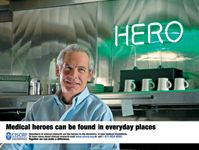Everyday Heroes Campaign Captures the Public
Applied Clinical Trials
Pilot test to rebrand clinical research shows promise as a way to build public trust and promote interest.
Most clinical research professionals now acknowledge that there is a critical need for general, broadly based outreach and education to assist in reversing the erosion of public trust. But this need is being underserved by the realities of today's research environment.

PHOTOGRAPHY: GETTY IMAGES ILLUSTRATION: PAUL A. BELCI
Facing finite resources and increasing difficulty recruiting study volunteers, sponsors, CROs, and investigative sites must address the intense and immediate pressure to fill their clinical trials. As such, communication with the public has focused almost entirely on attracting volunteers to a specific trial and not on improving the public's overall literacy in clinical research. Public outreach and education does not appear to have an attractive short-term return on investment. Until now.
The results of a recent pilot test conducted by Eli Lilly and Company show that The Center for Information & Study on Clinical Research Participation's (CISCRP) new public education program, "Everyday Heroes," can boost monthly enrollment rates substantially. Lilly found that running CISCRP's rebranding initiative concurrently with its subject recruitment advertisements for specific clinical trials generated more than a 35% improvement in monthly enrollees. This surprising finding suggests that public outreach and education, in conjunction with trial-specific outreach, may provide short-term benefits to accelerating subject recruitment activity for study sponsors.
This article is a sequel to our April 2007 Applied Clinical Trials article entitled "Mission Possible: Rebranding Clinical Research" and provides a discussion of this ground-breaking pilot study and its results and implication. As background, this article begins with a summary of the process undertaken to develop CISCRP's public education campaign.
Creating everyday heroes
Large-scale public education campaigns have proven to be a highly effective strategy for changing public perception and behavior in other sectors of the economy, such as blood donation, substance abuse, and save the environment movements. CISCRP created the Everyday Heroes Campaign to encourage the public to think differently about clinical research and to recognize the act of participation as a profound gift and a public good.
With an educational grant from Eli Lilly and pro bono collaborative support from Fast4wD Ogilvy—part of the health division of international advertising and marketing agency Ogilvy & Mather—CISCRP has spent the past two years developing and consumer testing a public education campaign.

Table 1. The outcome for Eli Lilly when it paired the Everyday Heroes campaign with recruitment ads for two pain studies.
In the fall of 2005, CISCRP, Lilly, and Fast4wD Ogilvy convened an initial meeting in Washington, DC, among a small, diverse group to discuss the difficulties of subject recruitment and retention and how to improve public education. That initial meeting brought together about two dozen people representing patient advocacy groups, the U.S. Food and Drug Administration, the Department of Health and Human Services, the National Institutes of Health, PhRMA (the Pharmaceutical Research and Manufacturers of America), the National Health Council, academic institutions, pharmaceutical companies, clinical research organizations, investigative sites, subject recruitment service companies, and the IRB community. The group reviewed extensive market research regarding why people choose to participate in clinical research studies. A brainstorming session was conducted to develop creative ideas to raise awareness and educate the public about volunteering for clinical trials.
At the conclusion of the initial small group meeting, Fast4wD Ogilvy reviewed attendee input and ideas and developed 15 different campaign ideas called "treatments." These treatments cut across a broad spectrum of educational approaches, some serious, some shocking, and some humorous to brand the impact that participation has on public health. One campaign featured ordinary people wearing superhero capes with emphasis on their contribution through participation. Another showed remedies applied to common medical ailments hundreds of years ago in order to capture how far medical knowledge has advanced.

One of several medical heroes featured in CISCRPs new public service ads for television. (PHOTOGRAPHY: CISCRP)
In early 2006, another meeting was held among nearly 60 research professionals. Again, this group was comprised of representatives from a broad spectrum of stakeholders in the clinical research enterprise. A major goal of this meeting was to solicit buy-in and support for the campaign moving forward. The group spent a full day reviewing, discussing, and modifying the 15 treatments. At the end of the meeting, the group selected its choice of the top five campaigns. After incorporating suggestions and refining the campaigns to make them look polished and professional, the five treatments were presented in March 2006 to consumer focus groups.
The focus groups included a representative mix of ages, genders, ethnicities, lifestyles, and occupations. Participants were grouped into one of three socio-economic classes. The Everyday Heroes Campaign scored significantly higher than the rest across the board. Consumers liked the concept and felt appreciative of the people featured in the campaign. Among the lower socio-economic group in particular, respondents identified with and admired the featured heroes engaged in everyday activities. The campaign also prompted all focus group participants to want to learn more and to acknowledge the gift that clinical trial participation gives to advancing medical knowledge.
In early 2007, following the focus group responses, Fast4wD Ogilvy and CISCRP refined the Heroes Campaign and developed a series of printed images and radio versions of the campaign. These images and radio spots can be reviewed on the CISCRP web site at www.ciscrp.org. A 60 second television spot, completed in early 2008, can also be viewed on the CISCRP Web site.
It's important to remember that the Everyday Heroes Campaign is disease neutral, as it does not focus on any specific illness, and it does not promote any specific clinical research program. The purpose of this educational campaign is not to recruit volunteers into studies currently enrolling volunteers or to promote newly approved treatments. Its purpose is simple: to raise awareness of and appreciation for those who participate in clinical research.

The pilot test
In June 2007, Lilly decided to pair the Everyday Heroes public outreach campaign with its efforts to recruit subjects for two pain studies—one focusing on back pain, the other on knee pain. These clinical studies involved approximately 30 investigative sites in 18 different geographic locations across the United States.
Over a three month period, Lilly ran its subject recruitment advertisements alone in 12 markets. And in six markets it ran the Everyday Heroes Campaign on the radio—in 30-second and 60-second formats—concurrently with its mass media (e.g., radio and television) subject recruitment ads. The public education campaign was never run immediately before or after a specific recruitment ad. Rather, it was presented independently, airing at different times of the day, but targeting the same demographic populations as the subject recruitment ads.
Across all 18 markets, when only a radio subject recruitment ad was used, investigative sites recruited an average of 2.9 subjects per month. During Wave 1 of the pilot test, however, in the six markets where recruitment ads and the Everyday Heroes Campaign aired on the radio concurrently, investigative sites enrolled an average of 4.0 subjects per month—a 38% increase. During this period, in the 12 markets receiving only a subject recruitment ad over the radio, sites continued to enroll an average of 2.9 subjects per month.
In the second month of the pilot test, Lilly dropped both the subject recruitment ads and the Everyday Heroes Campaign. During this period, enrollment rates in all 18 markets dropped significantly, as expected, to low and comparable base levels.
Then, during Wave 2 of the pilot test, Lilly observed a most dramatic effect. In this wave, Lilly ran television and radio subject recruitment ads in 12 markets. Investigative sites reported that their recruitment rates jumped to an average of 4.0 enrollments per month. But in the six markets where the television and radio recruitment ads were run concurrently with the Everyday Heroes Campaign, investigative sites saw an average of 9.6 enrollments per month: more than double the rate. Whereas enrollment rates for both cohorts increased during the subsequent wave, the cohort that included education and outreach saw a substantially higher response, suggesting a lasting impact, in part, from general awareness-building communication.
The pilot test clearly has its limitations. It focused on a single therapeutic area and used only a radio version of the Everyday Heroes program. Additional testing on the impact of this educational branding initiative across a variety of therapeutic areas and patient populations is needed to enrich our understanding. Still, the results of this initial pilot test are promising and intriguing. Following its pilot experience, Lilly is now using the Everyday Heroes Campaign across its portfolio of studies that are actively using media advertising to recruit volunteers.
Putting Everyday Heroes to work
At the present time, CISCRP has produced one television spot and two radio spots of the Everyday Heroes Campaign, as well as printed posters to hang onsite at investigative sites and health care provider offices. Print versions of the campaign are also available for local newspapers, magazines, and flyers. CISCRP is in the process of producing additional television and radio Everyday Heroes public educational spots.
The results of this pilot study offer insight into the power of a well-developed public education initiative running concurrently with clinical trial specific subject recruitment advertisements. Here are a few key insights:
- Patients seeking clinical trials see a connection with the very public message of the Everyday Heroes Campaign. The pilot test suggests the possibility that the more visible the public outreach campaign, the better the enrollment rates will be for clinical trials in general. Without overdoing it, broad and regular exposure of the Everyday Heroes Campaign benefits the whole clinical research enterprise and, ultimately, public health.
- The Everyday Heroes Campaign not only provides public education, but also can be considered within the context of trial-specific initiatives. Clinical research professionals—sponsors, CROs, investigative sites, and subject recruitment service providers—can and should factor the Everyday Heroes Campaign into their subject recruitment strategies and tactics. Its use creates a synergist effect that provides a better return on investment for advertising dollars spent.
- Investment in public education may indeed have a short-term, measurable impact on subject recruitment initiatives. As a result, requests for resources to support public education and outreach are justifiable. Moreover, the cost is minimal. CISCRP is making Everyday Heroes available—in print, radio, and television formats—to contributors of its national campaign for use concurrently with local subject recruitment campaigns. There is no incremental recruitment cost because sponsors, CROs, and sites are allocating a portion of their existing recruitment advertising budgets.
There is now a real opportunity to collectively use the Everyday Heroes educational campaign to both reverse the erosion of public trust in the clinical research enterprise and to promote appreciation and interest in clinical trial participation. It is our hope that the two year effort to create this re-branding initiative will culminate with its widespread adoption. There is nothing to lose and much to gain in collectively supporting public education and outreach in conjunction with clinical trial-specific promotion.
Kenneth Getz ,* MBA, is a senior research fellow at the Tufts Center for the Study of Drug Development and the chairman of the Center for Information and Study on Clinical Research Participation, both in Boston MA, email: Kenneth.getz@tufts.edu and kengetz@ciscrp.orgJames Kremidas is director of global enrollment optimization at Eli Lilly and Company in Indianapolis, IN. Emma Sergeant is group managing director of Ogilvy Healthworld in London, UK.
*To whom all correspondence should be addressed.
To watch the Everyday Heroes commercial, please visit www.youtube.com/watch?v=0r_ukszF_H4

Improving Relationships and Diversifying the Site Selection Process
April 17th 2025In this episode of the Applied Clinical Trials Podcast, Liz Beatty, co-founder and chief strategy officer, Inato, discusses a number of topics around site engagement including community-based sites, the role of technology in improving site/sponsor relationships, how increased operational costs are impacting the industry, and more.
SCOPE Summit 2025: Enhancing the Patient Experience Through Site Centricity
February 12th 2025In an interview with ACT senior editor Andy Studna at SCOPE Summit, Ashley Davidson, vice president, product lead - sponsor tech strategy, Advarra, highlights the need for more site-centric approaches in study startup.